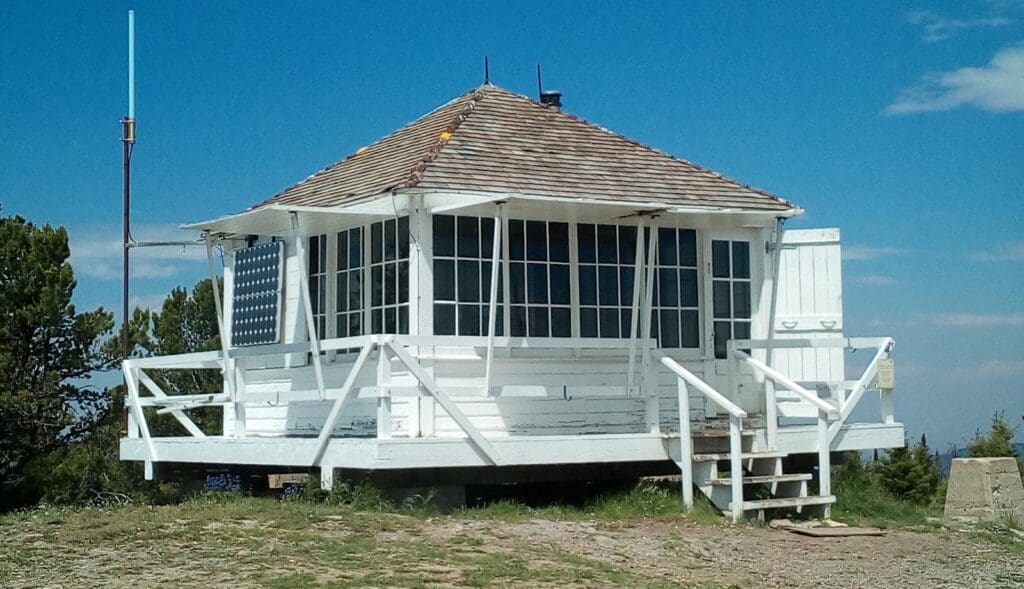|
Getting your Trinity Audio player ready...
|
Montana’s Big Sky, where the northern Great Plains meet the Rocky Mountains, is a wild and beautiful realm. From Glacier National Park to Yellowstone, Route 89 spans 370 miles of untouched nature and breathtaking views.
Overview
Nestled beneath the vast expanse of Montana’s Big Sky, where the rugged northern Great Plains meet the grandeur of the Rocky Mountains, lies a landscape that embodies the true essence of the American West.
Spanning from the majestic heights of Glacier National Park to the wild grasslands that have been immortalized by renowned artists like Charles M. Russell, Winold Reiss, John Louis Clarke and Victor Pepion, as well as Pulitzer Prize-winning author A. B. Guthrie, Jr., Route 89 offers an endless supply of untouched beauty and thrilling adventures. This extraordinary route stretches for over 370 miles, starting at the Canadian border in Montana and extending to the northern edges of Yellowstone National Park. With its unspoiled nature and stunning views, this epic journey attracts travelers throughout the year.
Begin your journey in the breathtaking Glacier National Park, then follow the historic U.S. 89 through the stunning landscapes that connect two of the most majestic national parks in the Western United States. Along the way, witness the mesmerizing sight of thousands of snow geese at Freezeout Lake, marvel at the impressive rock formation of First Peoples Buffalo Jump, and explore Giant Springs State Park. As you continue south towards Livingston, be sure to take in the enchanting scenery of Paradise Valley. This trip promises to be a thrilling adventure filled with scenic wonders and natural beauty.
Discover the wonders of Montana’s Big Sky Country in our Explorer’s Guide.
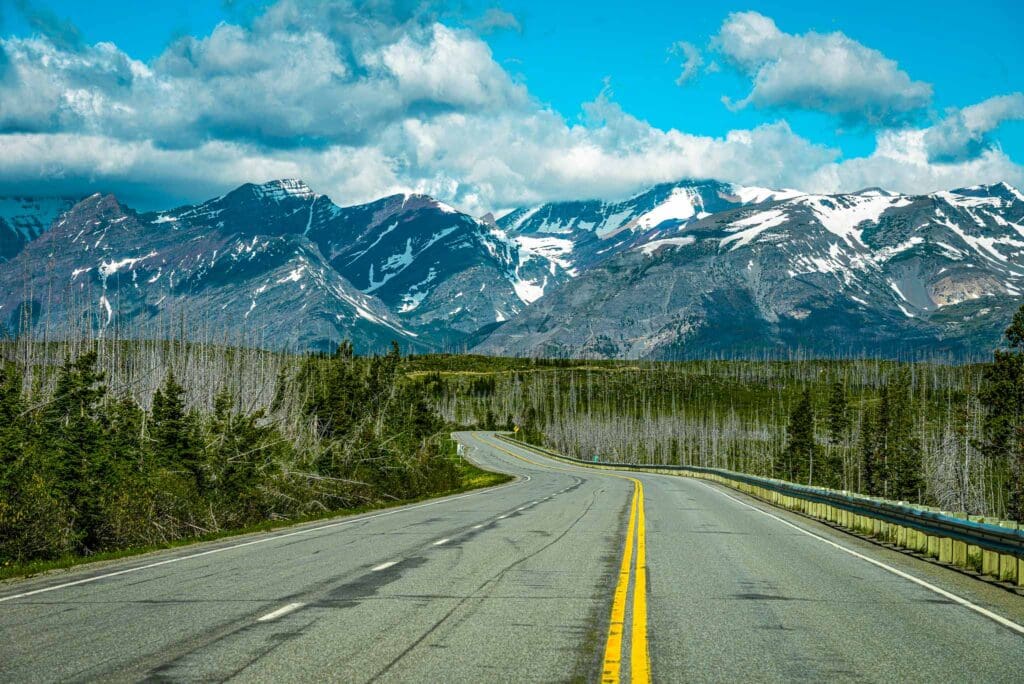
U.S. Route 89 extending towards snow-capped high mountain peaks in Glacier National Park, Montana.
Luxury Campervan Rentals for Iconic Road Trips: Moterra Campervans is your gateway to exploring America’s most beautiful landscapes with complete comfort and capability. Rent a luxury Mercedes Sprinter van fully loaded for road trips and vacations, with curated itineraries for national parks and other breathtaking public lands. Rental Hub located in Whitefish, Montana.
Book Now!
Table of Contents:
Article Navigation: Click on any of the listed items in the table of contents below to jump to that section of the article. Similarly, clicking on any large, white section header will jump you back to the Table of Contents.
- Overview
- Browning
- Blackleaf Wildlife Management Area
- Pine Butte Swamp Preserve
- Choteau
- Freezout Lake
- Great Falls
- Benton Lake National Wildlife Refuge
- Giant Springs State Park
- Kings Hill National Scenic Byway
- White Sulphur Springs
- Livingston
- Paradise Valley
- Emigrant
- Northern Yellowstone Winter Range
- Gardiner
Browning
As travelers make their treacherous descent down the eastern ramparts of the Rocky Mountains, they are greeted with a breathtaking and awe-inspiring sight. A sea of golden grass stretches endlessly before them, contrasted against the vibrant green willows and aspens that cling to the foot of the towering mountains. This natural boundary between the sprawling Great Plains and the majestic Rockies serves as a reminder of the beauty and adventure that awaits those brave enough to explore this rugged terrain.
With hearts pounding and eyes wide with wonder, explorers braved this wild land, cautious yet drawn to its untamed beauty. The Blackfeet tribe fiercely protected their territory, but now it invites visitors to experience the breathtaking 1.5 million acres of their reservation.
Embark on a journey through time and immerse yourself in the captivating history of the Northern Plains. Established in 1941, the Museum of the Plains Indian showcases a diverse collection of art from Northern Plains Tribal peoples, including the Blackfeet, Crow, Northern Cheyenne, Sioux, Assiniboine, Arapaho, Shoshone, Nez Perce, Flathead, Chippewa, and Cree. The exhibits feature a range of items such as traditional clothing, horse gear, weapons, household tools, baby carriers, and toys to provide insight into the history and culture of these tribes.
The Museum of the Plains Indian boasts a stunning collection of traditional arts, crafted by the skilled hands of indigenous peoples. Marvel at three intricate dioramas that bring to life the breathtaking landscapes and vibrant cultures of this region. Admire the masterful carved wood panels by renowned Blackfeet artist John Louis Clarke (1881-1970) and be awestruck by the majestic murals adorning the walls, created by gifted Blackfeet painter Victor Pepion.
Victor Pepion (1908-1956) was a highly regarded artist of the Blackfeet tribe, born in Browning, Montana in 1908. He was most renowned for his breathtaking murals, such as the famous ‘Buffalo Hunt’ piece displayed in the Museum of the Plains Indian lobby. Under the mentorship of Winold Reiss (1886-1953), a German American modernist artist known for his depictions of Blackfeet individuals, Pepion honed his skills in art and design. His wide-ranging body of work encompassed various mediums and styles, establishing him as one of the most versatile and prolific artists within the Blackfeet community. Pepion passed away in 1956 in his home state.
John Louis Clarke, also known as “Cutapuis,” was a skilled artist and woodcarver from East Glacier, Montana. Despite being deaf and mute, he gained recognition for his incredibly detailed carvings inspired by the wildlife of Glacier National Park. In fact, he often signed his pieces with his Blackfeet Indian name, which translates to “The-Man-Who-Talks-Not.” His extraordinary talent earned him numerous awards
Blackleaf Wildlife Management Area
A hidden gem awaits at the town of Bynum – the Blackleaf Wildlife Management Area. The winding gravel road will lead you through lush forests of timber pine, eventually ending at the breathtaking Blackleaf Canyon in the foothills of the Rockies. As you walk through the canyon, don’t be surprised to spot vibrant trillium and delicate lady slipper flowers dotting the landscape. Keep an eye out for majestic golden eagles and agile prairie falcons soaring above, and listen for the mesmerizing booming sound of sharp-tailed grouse engaged in their spring mating dance. Truly a nature lover’s paradise, every step is an adventure waiting to be discovered.
Pine Butte Swamp Preserve
As the highway snakes its way north of Choteau, it reaches the glistening Teton River. The soothing murmur of pebbled shallows echoes through the air, complemented by the rustling of quaking aspens along the river banks. A small road veering west from Route 89 traces the Teton for 17 picturesque miles. Following a turn south, you’ll find yourself crossing the Teton to reach the Pine Butte Swamp Preserve – an expansive 18,000 acre sanctuary owned by the esteemed Nature Conservancy.
This refuge houses a lush array of landscapes including tangled swamp bottoms, rolling hills, and vast grasslands, all crowned by a towering 500-foot sandstone butte. Amidst this tranquil haven, more than 150 species of birds fill the air with their joyful melodies – chattering, cawing, and trilling in blissful abandon. And let’s not forget about the majestic grizzlies who have sought solace in this peaceful oasis, their numbers dwindling since pioneer days when over 100,000 roamed wild throughout western North America.
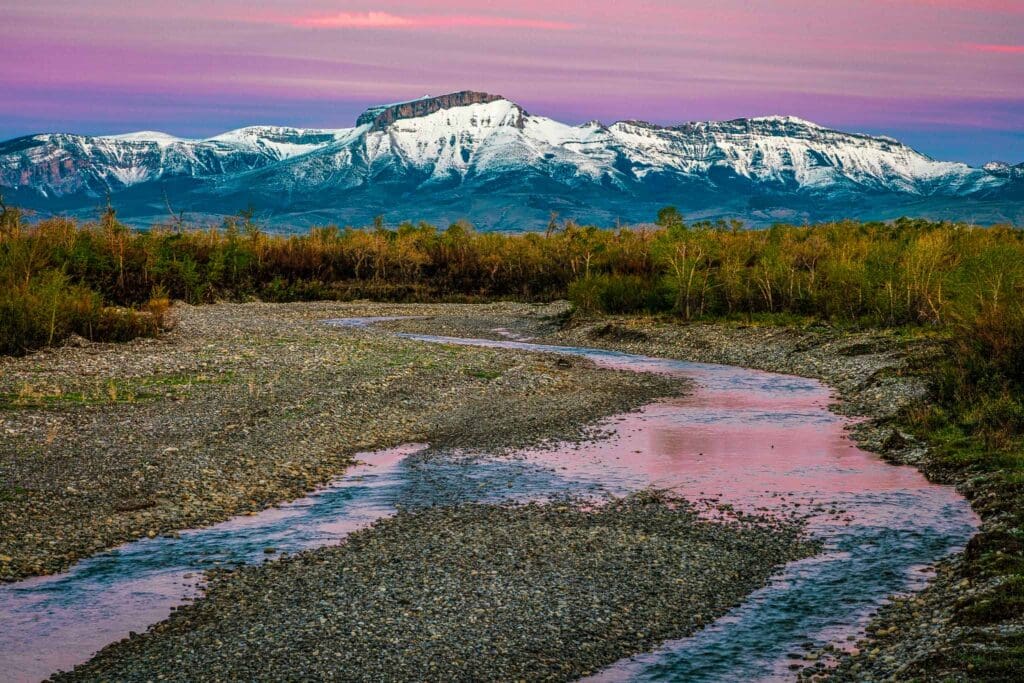
Dawn along the Teton River with Ear Mountain in background near Choteau, Montana. Photo by Danita Delimont.
Choteau
The people of Montana have a special name for the ethereal sunlight that filters through the clouds, painting the vast prairies below with radiant beams. It is known as God Light, and it is a true testament to the breathtaking vistas of this land.
So moved was Pulitzer Prize-winning author A. B. Guthrie, Jr., who resided in Choteau, by the grandeur of Montana’s natural landscape that he chose to entitle his 1947 Western novel, The Big Sky. The Big Sky is the first of six Western novels by A. B. Guthrie Jr., following the development of Montana from the mountain men of the 1830s to the cattle empire of the 1880s. It is a classic portrayal of America’s wild frontier and introduced iconic characters such as Boone Caudill, Jim Deakins, and Dick Summers who journeyed along the Missouri River from St. Louis to the Rockies as trappers, traders, guides, and explorers. These frontiersmen embark on a rugged and wild life filled with danger and discovery.
The sequel, The Way West, the 1949 western novel by A. B. Guthrie Jr., won the Pulitzer Prize for Fiction in 1950 and was adapted into a film starring Kirk Douglas, Robert Mitchum, and Richard Widmark.
The patchwork of yellow and black fields, representing grain and fallow soil, outline the planting pattern of Choteau. This town is renowned for its bountiful wheat and barley crops and takes great pride in its pioneer heritage as seen in the rugged quarry stones of the old courthouse. But Choteau also looks to a time much further back in history. The Old Trail Museum on Main Street showcases the fossilized remains of Maisaura dinosaurs, which once roamed this area.
Nearby Egg Mountain, a nesting ground for Maisaura, was where the first dinosaur egg was discovered in the Western Hemisphere. Paleontologists from the Museum of the Rockies regularly conduct excavations at local “bone beds.” The human history here is also ancient: just west of the Sawtooth Range lies a trail that is believed to have been blazed by Proto-Indians from Mongolia thousands of years ago during the Ice Age when they crossed over the land bridge from Asia.
In 1978, a resident of Bynum, Montana named Laurie Trexler stumbled upon an unknown species, later known as Maiasaura. Around the same time, Marion Branvold discovered more of this species in the badlands south of Choteau, Montana. This area would be known as Egg Mountain and is a prominent location in the Two Medicine formation. The findings by Branvold challenged established beliefs about dinosaurs in the field of paleontology and eventually led to Maiasaura being chosen as the official state fossil of Montana.
Branvold made a groundbreaking discovery of nests belonging to hadrosaurs, also known as “duck-billed” dinosaurs. Along with these finds were specimens from various stages of the hadrosaur’s life, indicating that they lived in herds throughout their lives. This discovery completely altered the existing understanding of dinosaur behavior and life cycles amongst paleontologists.
Freezout Lake
Located approximately 10 miles south of Choteau, the marshy grounds of Freezout Lake stretch out towards the western horizon. During the spring and fall migrations, this area becomes a haven for water fowl, attracting more birds than any other place in Montana. Over a million birds make their way to the sanctuary’s 12,000 acres, including about 300,000 snow geese and numerous other species with charming names like long-billed curlews, marbled godwits, white-faced ibises, sandhill cranes, tundra swans, cinnamon teal, as well as shorebirds from California and gulls from Peru.
Great Falls
As Meriwether Lewis laid eyes upon the majestic Great Falls of the Missouri in 1805, he was overwhelmed with awe and declared them the most magnificent sight he had ever seen. Yet, those breathtaking cascades have since been tamed by man-made dams, robbing them of their natural splendor. In present-day, Great Falls stands as the second largest city in Montana, its inhabitants boasting more about economic prosperity and electricity production than the once-thriving beauty of nature that captivated Lewis centuries ago.
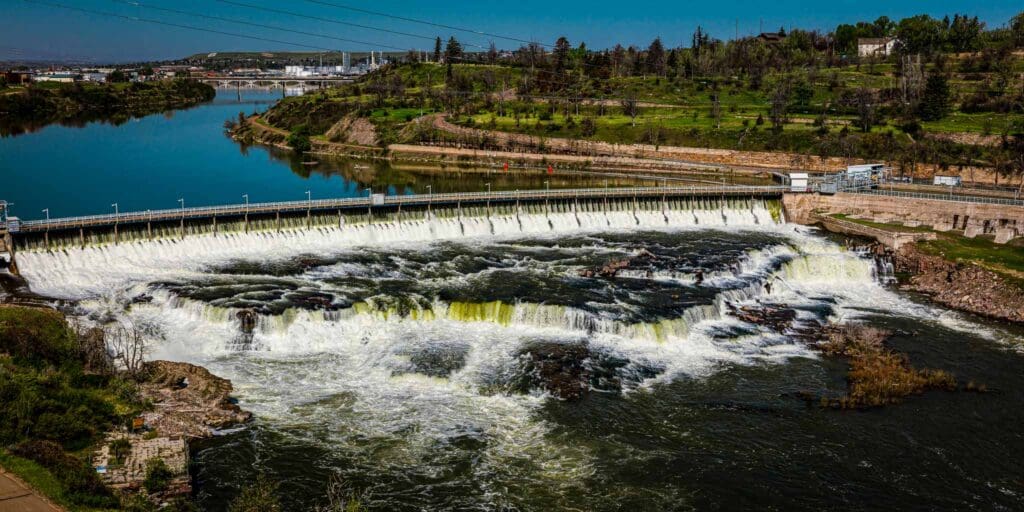
Black Eagle Dam of the Great Falls of the Missouri River, Great Falls, Montana.
The bustling city and its surroundings hold a special place in the heart of those familiar with Charlie Russell’s legacy. The esteemed artist resided in Great Falls for a significant portion of his life, drawing inspiration from the area’s wild history of cow-punching.
Hailing from the plains of Missouri, Charlie Russell inherited a deep-rooted love for the rugged cowpokes and fearless Native Americans who roamed the American West. Even as a young boy, he captured this fascination in his vivid drawings. At the age of 15, his parents shipped him off to Montana in hopes of eradicating his obsession with the untamed frontier. Instead, he emerged as a true cowboy, immersing himself in the thrilling lifestyle that he would later immortalize through his extraordinary paintings, watercolors, and sculptures – a timeless ode to the wild and untamable spirit of the land.
The Wild West was Charles Marion Russell’s canvas, where he brought to life over 2,000 paintings of cowboys, Native Americans, and expansive landscapes stretching across the American frontier and into Alberta. But his artistic legacy goes beyond just capturing the rugged beauty of the west. Russell was also a passionate storyteller and author who championed for the rights of Native Americans. His unwavering advocacy helped establish the Rocky Boy Reservation in Montana in 1916.
Today, the C.M. Russell Museum Complex in Great Falls houses his masterful artworks, personal belongings, and artifacts that continue to inspire and awe adventurers and history enthusiasts alike. Visitors can explore his masterpieces at the C.M. Russell Museum on 13th Street North, which features an array of oil paintings, watercolors, and sculptures in wood and bronze. The museum also houses personal items such as illustrated letters and memorabilia showcasing Russell’s life, as well as works by other talented Western artists. Don’t miss out on touring Russell’s former residence and his log cabin studio, where he created the majority of his exceptional artwork.
Benton Lake National Wildlife Refuge
Benton Lake National Wildlife Refuge is a vast 12,459-acre area located about 12 miles north of Great Falls, an oasis of diverse landscapes – a vast expanse of shortgrass prairie dotted with seasonal wetlands and the shimmering Benton Lake. This sanctuary lies on the western fringe of the northern Great Plains, where a 6,000-acre wetland teems with life. These prairie potholes are nature’s handiwork, formed by melting glacial ice. A breathtaking way to experience this refuge is through the serene Prairie Marsh Wildlife Drive.
As the seasons change, a massive influx of wildlife floods the marsh: 150,000 ducks quack and flap their wings, 2,500 Canada geese honk and soar, 40,000 snow geese squawk and scatter, 5,000 tundra swans trumpet and glide, and an estimated 50,000 shorebirds flutter and peck. Every year, an astonishing 20,000 new ducklings are added to the marsh’s already bustling population, while colonies of Franklin’s gulls nest in groups of over 10,000. Among this diverse avian community are striking species like avocets, phalaropes, willets, and grebes.
And soaring above it all are powerful predators: bald eagles with piercing eyes, golden eagles with razor-sharp talons, prairie falcons with deadly speed, and peregrine falcons with unmatched precision. Even more impressive is the fact that nearly 90 of the 240 recorded bird species on the refuge actually choose to make it their home. But birds aren’t the only residents here; 28 different mammal species also call this place home. Coyotes howl at night while muskrats build their dens by day. Badgers roam the grasslands alongside graceful white-tailed deer and mule deer. And among the prairie shrubs live elusive pronghorn with lightning-fast reflexes. The refuge truly teems with life in every corner.
Explore the Prairie Marsh Wildlife Drive, a 9-mile gravel road open year-round for daylight hours only (may close due to weather). Spot elusive wildlife and their habitats through keen observation and a bit of luck. Don’t miss your chance to see active animals during early mornings or late afternoons. With peak water conditions in spring and fall, witness migrating ducks, geese, swans, and shorebirds. Stop at the ten designated points along the drive for an immersive experience, reflecting on the diverse species, habitats, history, and management of Benton Lake NWR. Maps available at the Information Kiosk.
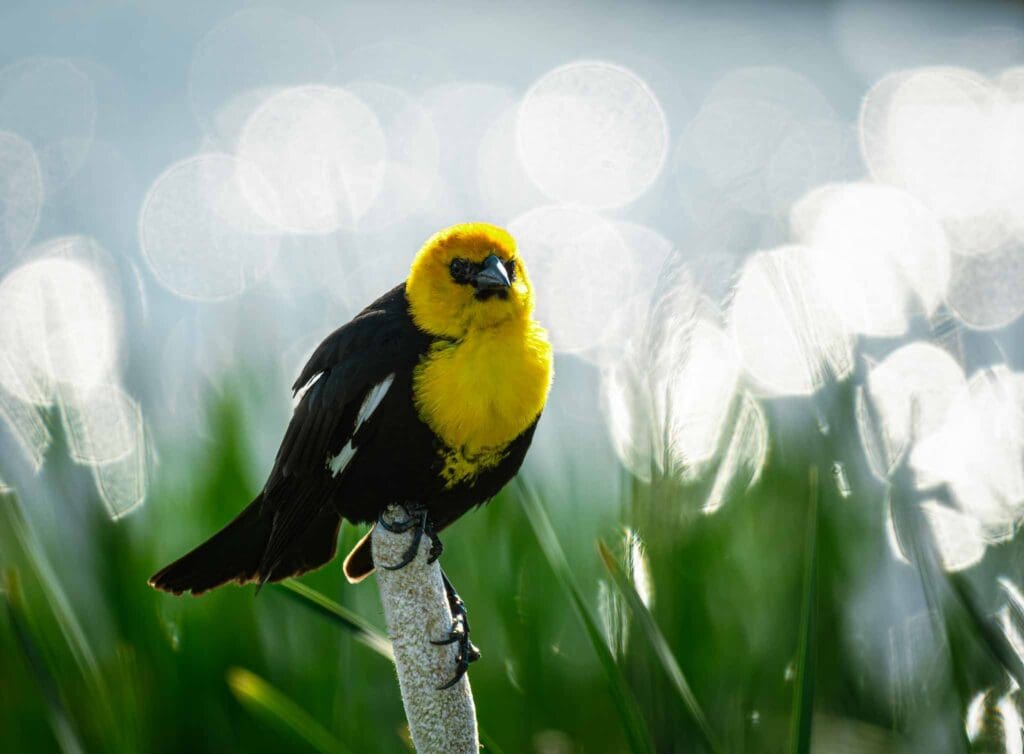
Yellow-headed blackbird perched on a cattail in Benton Lake National Wildlife Refuge near Great Falls, Montana.
Giant Springs State Park
Nestled on the south bank of the Missouri River, just east of Great Falls, lies Giant Springs State Park. A breathtaking sight to behold, this hidden gem boasts an impressive flow of 190 million gallons of icy, mineral-rich water daily from deep within its rocky crevices. This natural wonder is believed to be supplied by the purest rain and snowmelt from the rugged Little Belt Mountains that lie southeast of town. From the bustling city of Great Falls, the majestic peaks of the range resemble a flock of sheep huddled together, their rugged contours carved by ancient glaciers.
Experience the wonders of Giant Springs State Park, located near Great Falls and boasting 14 miles of Missouri River shoreline. Enjoy hiking, biking, picnicking, photography, fishing, hunting, boating, and bird watching at this day-use park with no camping available. Listen to the serene sounds of water cascading into the Roe River, known as the world’s shortest river. Explore the Fish Hatchery and visitor center or have a picnic among the towering trees and manicured lawn. Don’t forget your binoculars or camera for birdwatching opportunities.
For those seeking more active options, Giant Springs offers excellent fishing spots along the Missouri River as well as a separate pond for fishing. The park also boasts over 30 miles of paved and dirt trails for walking, running, or biking, ranging in difficulty from easy to challenging. These trails are all part of the larger River’s Edge Trail System, which covers nearly 60 miles around the Great Falls area. Within the park, visitors can also take a stroll or drive to see four waterfalls (five if you count Colter Falls, now buried). Along with its natural beauty, Giant Springs is also rich in history – from being explored by Lewis and Clark to being used for silver smelting and even having ties to Paris Gibson, the founder of Great Falls.
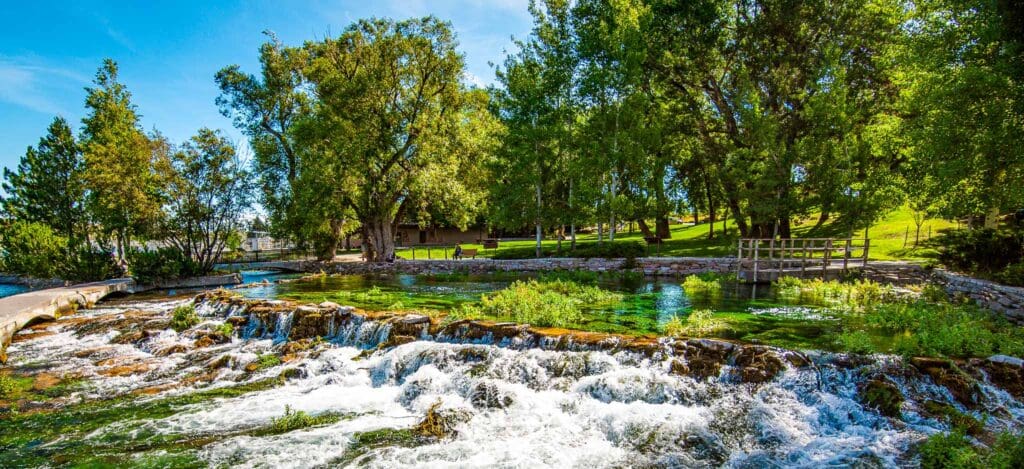
Giant Springs State Park, Montana.
Kings Hill National Scenic Byway
South of Great Falls, the land has been heavily impacted by human activity such as plowing, logging, and mining. However, its beauty and peacefulness remain unscathed. In this region, known as “God’s Light,” the sun illuminates the rolling prairies and fields of wheat with radiant beams and shadows from passing clouds.
In the United States, there are 120 designated National Scenic Byways – stretches of road that pass through areas of notable significance. These regions may be known for their natural beauty, cultural heritage, historical events, archaeological discoveries, or recreational activities. One of these byways is the Kings Hill Scenic Byway in Montana. This particular route has been recognized by the state for its stunning scenery, abundant nature, rich history, and various recreational opportunities. It spans 71 miles (114 km) along US Highway 89, traversing the Little Belt Mountains between junctions with US Highway 12 and US Highway 87.
Stretching 71.2 miles along the meandering curves of Belt Creek, the Kings Hill National Scenic Byway calls to those who crave adventure in its rugged landscape. Running from Armington Junction to White Sulphur Springs, this north-south road can be challenging to navigate during winter months, so it’s best to check road conditions beforehand. At the summit, an observation tower awaits, providing breathtaking views of the Helena-Lewis and Clark National Forest that are often sought after by visitors.
Upon arriving in Monarch, an 1880’s silver mining town nestled under Sun Mountain, one can almost hear the aspen trees applauding their arrival. Though now known for skiing thrills, Monarch once flourished like its neighbor Neihard. Despite its sleepy state today, Monarch boasts a treasure trove of Victorian-style homes that serve as stunning reminders of its hopeful past.
Continuing through the Lewis and Clark National Forest and Little Belt Mountains, the Kings Hill National Scenic Byway offers travelers a leisurely opportunity to savor the rugged beauty and refreshing mountain air that Montana is known for. This byway guides visitors through pristine lakes and streams, home to various wildlife species.
The network of gravel roads branching off from the main highway leads to 450 miles of breathtaking mountain views, high country lakes, trailheads, campgrounds, and abandoned mines. Showdown Ski Area, situated just south of Kings Hill Pass, provides a vertical drop of 1,400 feet and 34 runs for avid skiers.
For those seeking other outdoor activities, fishing, floating, mountain biking, horseback riding, and snowmobiling are popular options in this rugged landscape waiting to be discovered. The Kings Hill Snowmobile parking lot located north of Showdown Ski Area offers access to 200 miles of marked snowmobile trails. Additionally, Silvercrest, a 17-mile cross-country ski trail system with one ungroomed and three groomed trails, can be accessed from the same location.
Good To Know: Located in Helena-Lewis and Clark National Forest near White Sulphur Springs, Montana, sits Monument Peak Lookout (located at 46° 59′ 52.0001″ N 111° 5′ 53.9999″ W) , which can be rented for overnight stays at Recreation.gov. This unique structure, constructed by the Civilian Conservation Corps in 1936, provides visitors with a rustic yet breathtaking room. Perched at the peak of Monument Peak, guests can enjoy stunning 360 degree views of the Little Belt Mountains. The lookout sits at 7,395 feet in elevation, offering views of Monument Ridge and Strawberry Ridge. Originally used for fire surveillance, the lookout has been unused since the 1970s.
White Sulphur Springs
Nestled in the embrace of towering mountains lies this idyllic village, its mineral baths providing a warm respite for weary travelers. As you look south, the vast Shields River plain unfolds before you, a canvas of lush farmland and sprawling ranches. The natural beauty of this place was so irresistible that even famed circus owner John Ringling was drawn to it, giving the nearby town its fitting name: Circus City, just 20 miles from White Sulpher Springs.
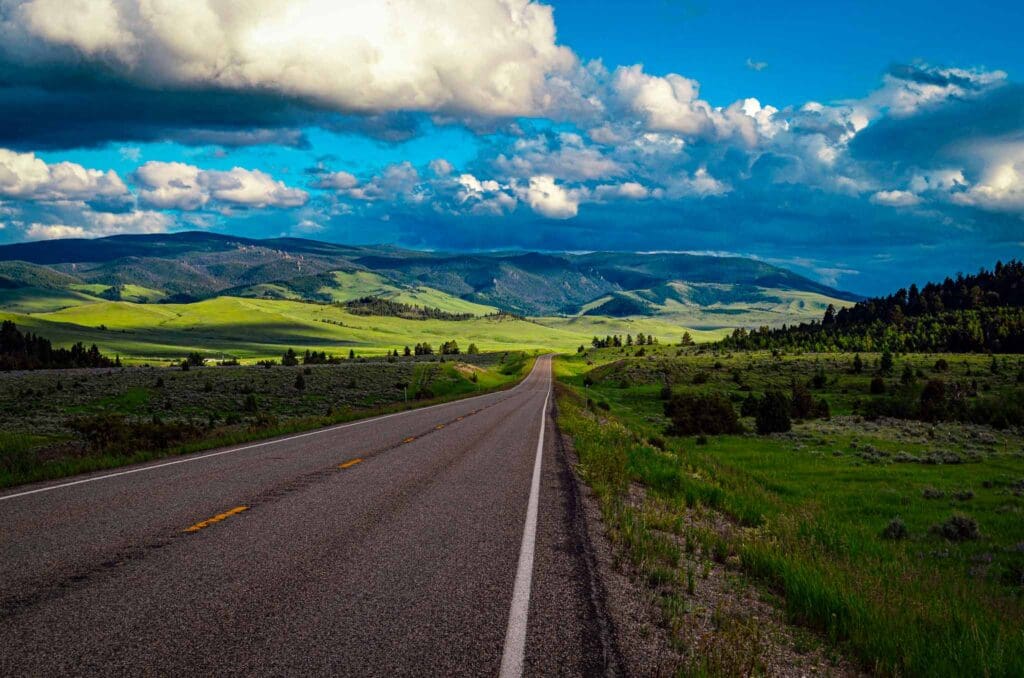
Drifting Clouds over Highway 89 approaching White Sulphur Springs.
Livingston
Nestled at the junction of the Shields and Yellowstone rivers, Livingston was birthed by the Northern Pacific Railroad. Once a rough and tumble hub for trainmen, it now attracts a diverse community of writers, artists, and even Hollywood stars. While modernization has crept in with trendy cafes and boutiques, Livingstone remains dedicated to preserving its rich history. Over 400 buildings, including a stunning railway depot turned museum, are listed as National Historic Places. As a haven for trout fishing, the most revered destination is Dan Bailey’s Fly Shop, renowned among fishermen worldwide for its mail order business. Nature truly reigns supreme in this picturesque town.
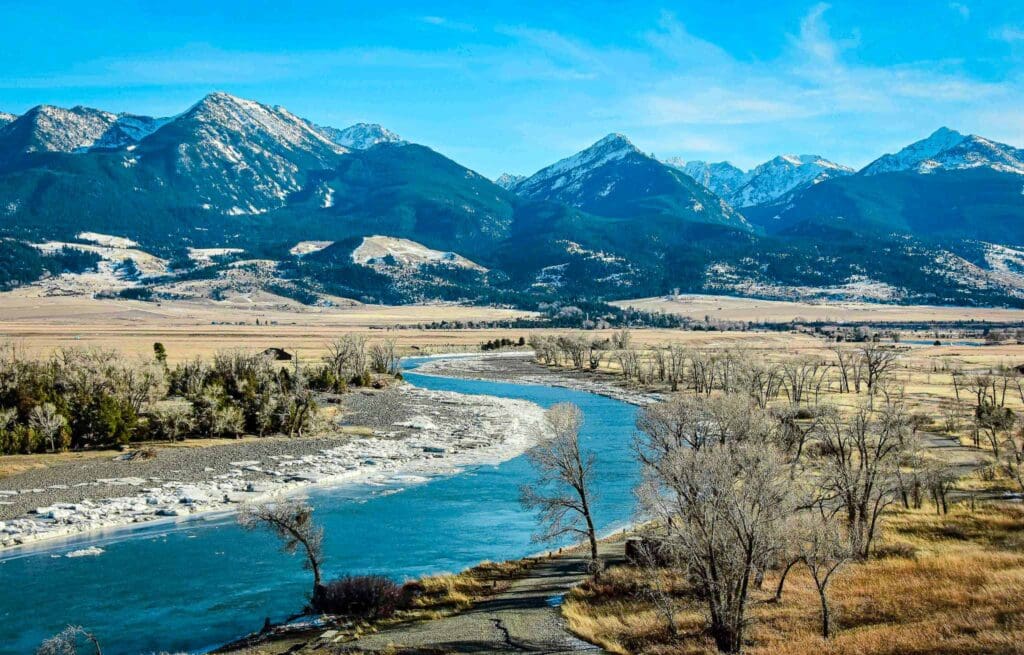
The picturesque winter scenery on a bright, sunny day at Mallard’s Rest fishing access along the Paradise Valley Scenic Loop of the Yellowstone River and Gallatin Range, south of Livingston, Montana.
Paradise Valley
Nestled between the rugged Absaroka and Gallatin ranges, this secluded alluvial plain unfolds south of Livingstone, cradling the sparkling Yellowstone River. Revered by fly fishing enthusiasts as America’s top cold-water trout stream, this stretch of water is flanked by Route 89 and East River Road (Route 540) on opposite banks. As you travel southbound through old ranch land, your eyes will be drawn to the majestic North Absaroka Mountains rising to the east, crowned with lush greenery and home to the untamed wilderness of the Absaroka-Beartooth Wilderness. And while nature may seem peaceful here, traces of volcanic activity remind us of the power and unpredictability of the environment – a fiery reminder that keeps the nearby Sage Lodge simmering with life.
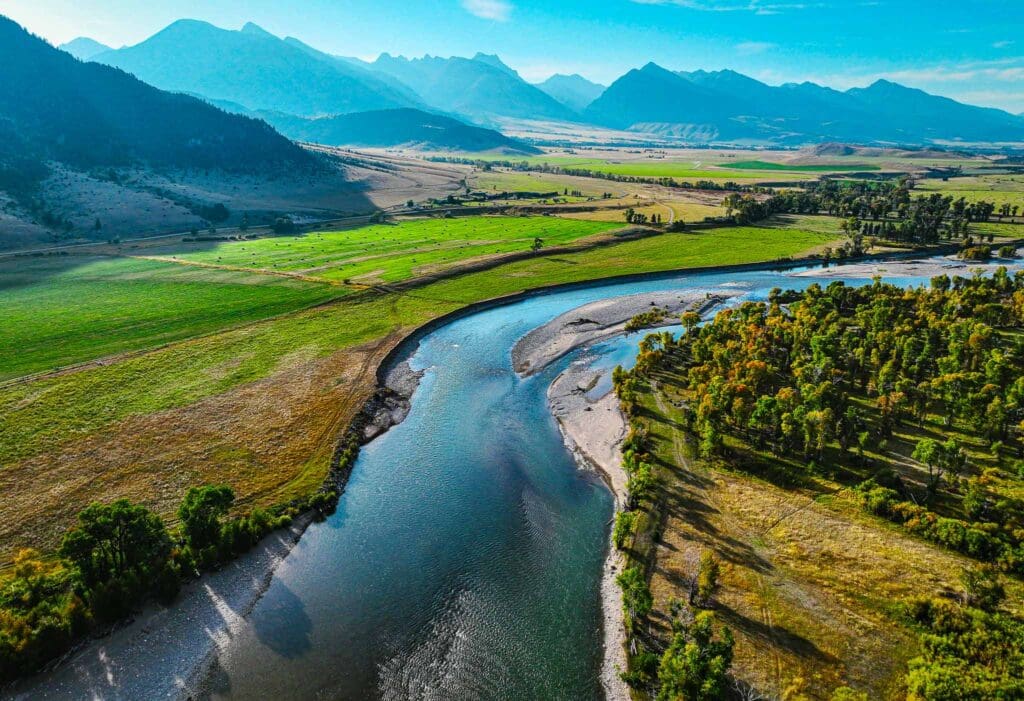
Paradise Valley in the Fall, Livingston, Montana.
Emigrant
As you venture south through the quaint town of Emigrant, the towering 10,921-foot peak of Emigrant Peak greets you. This is just a glimpse of the majestic Absaroka Mountains, reaching heights of up to 12,799 feet – the highest in Montana. As you journey further, you’ll come across the Gallatin Petrified Forest where fascinating mineralized hardwoods can be found. These ancient trees give us a glimpse into the past, hinting at a tropical environment during the age of dinosaurs. For those eager to take home a piece of this natural wonder, permits are available in Livingston or Gardiner before embarking on the gravel road leading to the petrified forest from Tom Miner Bridge. Get ready for an adventure through time and nature like no other.
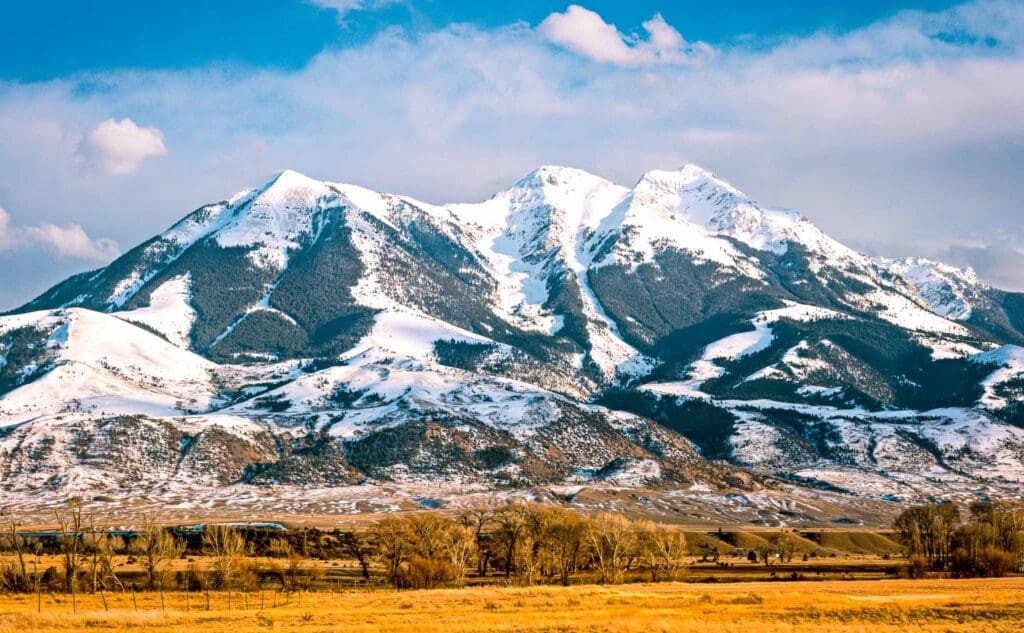
Emigrant Peak
Northern Yellowstone Winter Range
Heading further down Route 89, the solid granite walls of Yankee Jim Canyon narrow and create a deep gorge. The powerful Yellowstone River rushes through, crashing against rocks and debris with intense force. In the spring, these raging rapids are only for experienced white water enthusiasts to brave.
Near Corwin Springs, a streak of red called Devils Slide is visible on the side of 7,176-foot Cinnabar Mountain to the southwest. When miners first arrived in the area, they wrongly identified this weathered layer of sandstone and shale as containing mercury ore. This led to the mountain being named Cinnabar, after the mistaken belief.
Keep an eye out for wildlife during the colder months, as this area serves as the winter habitat for a wide variety of hoofed animals, making it the largest population in the lower 48 states. These include bighorn sheep, pronghorn antelope, mule deer, elk, bison, and other species that migrate to Yellowstone during the warmer months.
Gardiner
With only about 600 residents, this quaint community is the sole year-round entrance to Yellowstone National Park for vehicles. The brownstone Roosevelt Arch, which was opened in 1903 by Theodore Roosevelt himself, serves as the original northern gateway to the park. The inscription that Teddy personally carved into the top of the arch seems fitting not just for what lies ahead, but also for the journey that brought you here: “For The Benefit And Enjoyment Of The People.”
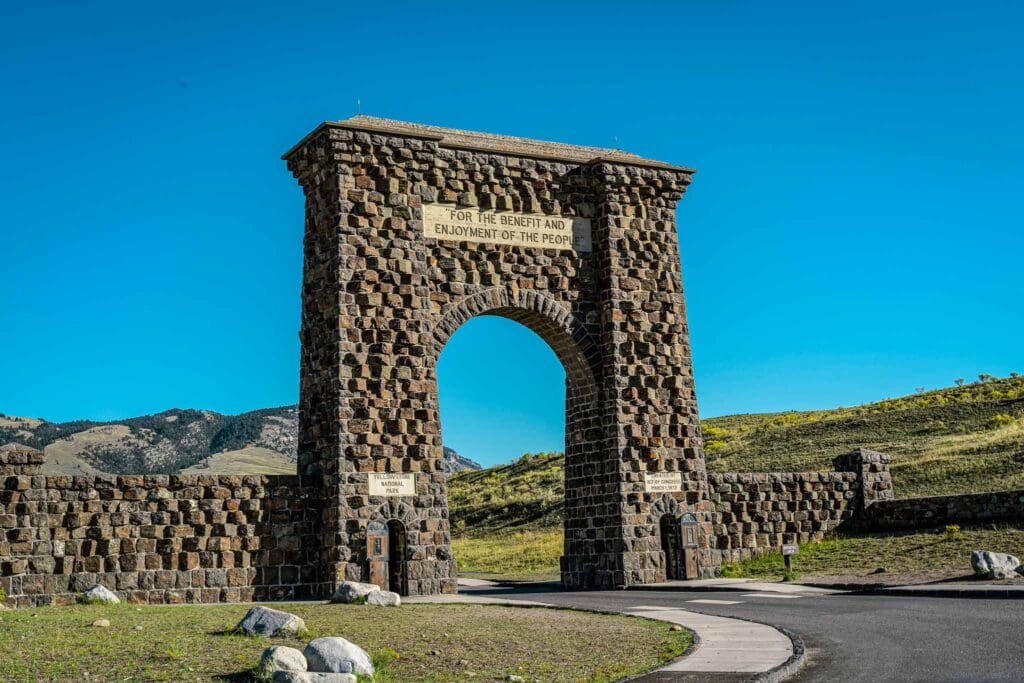
Historic Roosevelt Arch at the North Entrance of Yellowstone National Park, Gardiner Montana.
Popular Articles:
Adventurer’s Guide to Glacier National Park, Montana
Explorer’s Guide to the Flathead Country Loop, Montana
Rugged Beauty in the Isle of Skye, A Portrait Artist’s View





